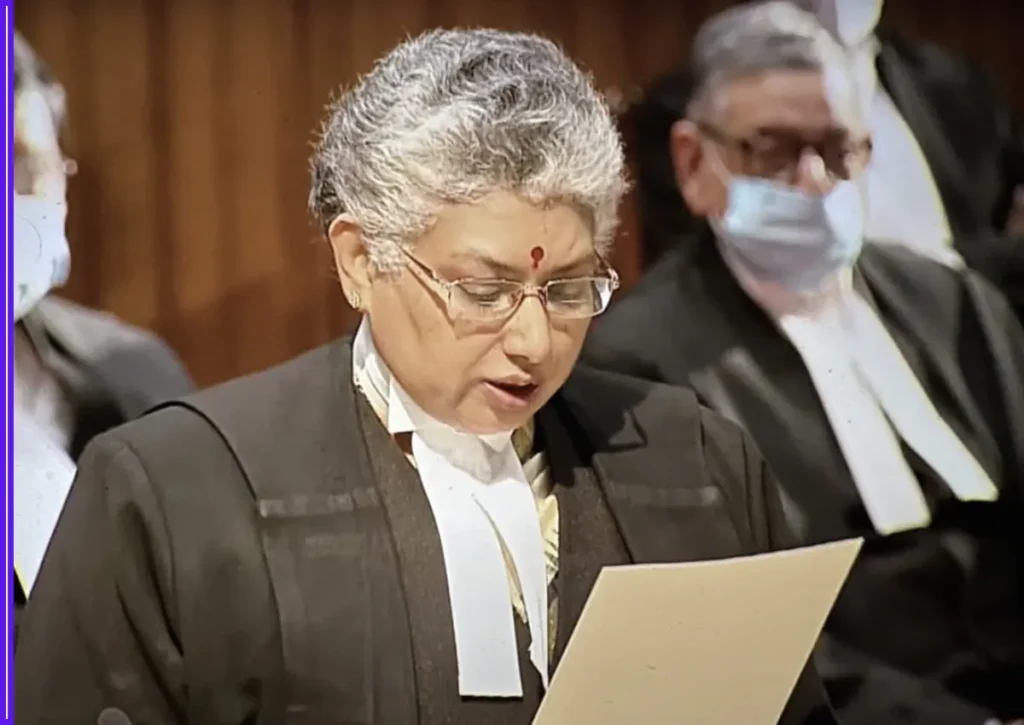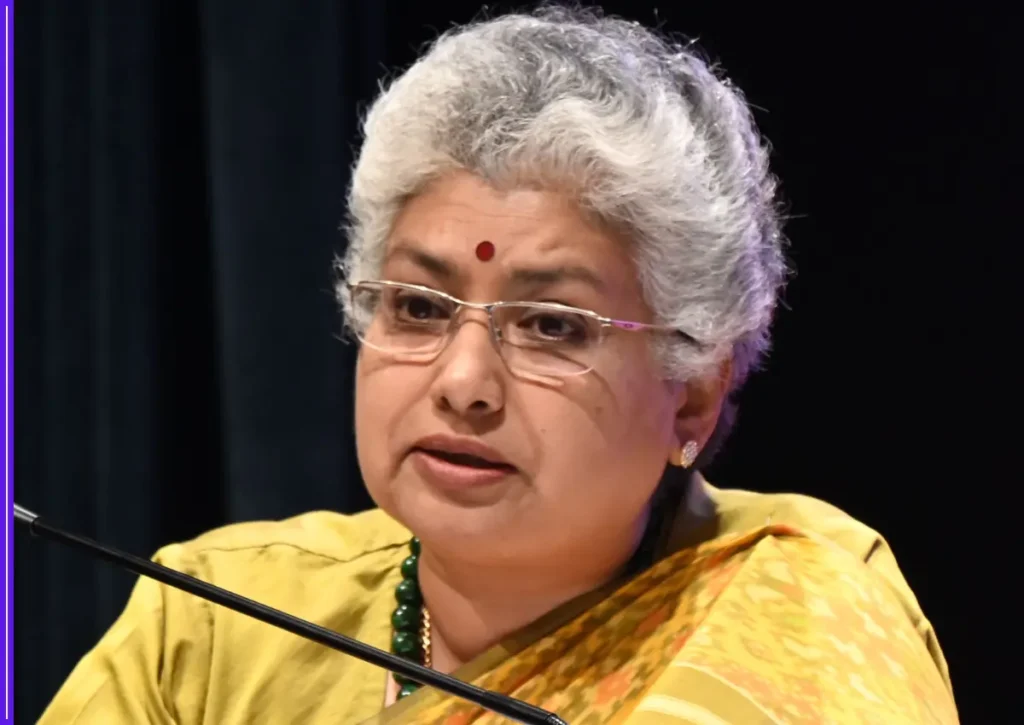Early life and family influence
Justice B.V. Nagarathna’s story begins in Bengaluru, Karnataka, where she was born on 30 October 1962 into a family that understood law not as a profession alone but as a way of life. Her father, Justice E.S. Venkataramiah, was a towering legal mind who went on to become the 19th Chief Justice of India. From her earliest days, she grew up in a household where conversations about constitutional principles, democracy, fairness, and governance were part of the daily atmosphere. The sense of justice that would later guide her as a judge was first instilled at the family dining table, where values of honesty, integrity, and service to society were emphasized above all else.

Though her father’s stature was immense, young Nagarathna was never one to rely on his reputation. Teachers and family members remember her as a bright, inquisitive child who loved books, debates, and history lessons. She had a deep curiosity about how society worked and why rules mattered. While many children dream of glamorous professions, her world was shaped by the courtroom stories and judicial ethics she overheard at home. What left a lasting impact on her was not her father’s success but his humility, his discipline, and his belief that a judge must always place the Constitution above personal interest. These lessons became the foundation of her character.
Education and the making of a lawyer
Nagarathna’s formal education began in Bengaluru, where she displayed remarkable discipline and academic excellence. She was a keen reader and an enthusiastic debater, qualities that would serve her well in the courtroom later. After completing her schooling, she decided to pursue law at the prestigious Campus Law Centre, Delhi University. This choice was not surprising, but it was bold, because studying in Delhi meant stepping out of her comfort zone and immersing herself in a vibrant, competitive environment.
At Delhi University, she encountered a diverse group of students, future lawyers, and professors who pushed her to think beyond traditional boundaries. Constitutional law, administrative law, and jurisprudence fascinated her. She developed a strong sense of how the law could serve as a living instrument to protect citizens and hold power accountable. Classmates recall her as serious yet approachable, someone who combined academic focus with a sense of fairness.
By the time she completed her degree, it was clear that she was ready to build her career on her own terms. In 1987, she enrolled with the Karnataka Bar Council and began practicing at the Karnataka High Court.
Early years in legal practice
The late 1980s and early 1990s were not easy years for women entering the legal profession. Courtrooms were dominated by male advocates, and women often had to work twice as hard to be taken seriously. Nagarathna faced these realities head-on. She specialized in constitutional law, commercial disputes, family law, and administrative cases. Clients admired her clarity of thought, her calm presence, and her ability to make complex issues sound simple.
Many young lawyers begin by working under senior advocates, but Nagarathna gradually built her independent identity. She argued cases not only in the Karnataka High Court but also before subordinate courts and tribunals. Every case, whether large or small, was approached with the same dedication. She never sought special treatment because of her family name; instead, she wanted her arguments to stand on their own merit. Those years at the Bar taught her resilience, patience, and the ability to navigate a male-dominated space with grace and strength.
Appointment as a judge in Karnataka High Court
Her judicial career began on 18 February 2008, when she was appointed an Additional Judge of the Karnataka High Court. A year later, she was confirmed as a permanent judge. The transition from lawyer to judge is never easy. As an advocate, one fights for a client, but as a judge, one must rise above personal arguments to look at the broader principles of law and justice. Justice Nagarathna made this shift seamlessly.
From the very beginning, she developed a reputation for her calm demeanor and patient hearings. Lawyers who appeared before her recall that she listened attentively, encouraged young advocates to present their arguments fully, and always conducted proceedings with dignity. For her, the courtroom was not a battlefield but a temple of justice.
During her High Court years, she dealt with a wide variety of cases. Whether it was constitutional issues, family disputes, or commercial conflicts, her judgments reflected clarity, compassion, and a deep respect for the Constitution. She consistently emphasized that the judiciary must remain independent of external pressures and that judges should interpret the law in a way that strengthens democracy.
Philosophy of law and justice
Justice Nagarathna’s approach to law has always combined precision with empathy. She believes that while statutes and precedents form the backbone of the judiciary, justice is ultimately about people. Her judgments reveal a consistent attempt to balance the letter of the law with the spirit of fairness.
She has written and spoken about the importance of freedom of speech and expression, underlining that democracy cannot thrive if citizens are silenced. In her view, dissent is not a threat but a sign of a healthy society. She has also been a strong voice for gender justice, pointing out that equality is not merely about numbers but about breaking stereotypes that limit women’s opportunities.
Journey to the Supreme Court
On 31 August 2021, Justice Nagarathna was elevated to the Supreme Court of India, a milestone that brought her national recognition. At the highest court, she became part of landmark benches dealing with issues that shaped the future of Indian democracy. Her judgments in the Supreme Court reflect the same qualities she displayed in the High Court: independence, courage, and clarity.
Perhaps her most talked-about contribution has been her dissent in the 2023 demonetization case. While the majority upheld the government’s decision, Justice Nagarathna argued that the process was unconstitutional because proper procedures were not followed. Though in minority, her opinion was widely appreciated by legal scholars and the public alike. It reminded the nation that dissent within the judiciary is vital, as it keeps the system accountable and preserves the integrity of constitutional processes.
Her dissent was not just a legal position; it was a statement of principle. It demonstrated that judges must not hesitate to speak the truth, even if they stand alone. This courage has become her defining trait in the Supreme Court.
Challenges and resilience
Justice Nagarathna’s journey was not without hurdles. Being a woman in a male-dominated profession, especially in the 1980s and 1990s, meant facing skepticism and bias. Many doubted whether women could handle the pressures of litigation. She also carried the weight of being the daughter of a former Chief Justice of India, which led some to assume that her path would be easier. In reality, she had to work harder to prove her merit and dispel such assumptions.
What kept her steady was her resilience, her quiet strength, and her focus on the work itself. Instead of reacting to stereotypes, she let her judgments and her arguments speak for her. Over time, respect followed naturally, both from colleagues and the wider legal community.
Personality and leadership style
Those who have interacted with Justice Nagarathna describe her as soft-spoken yet firm. She does not raise her voice to command authority; instead, her clarity of thought and calm demeanor naturally command respect. She is deeply disciplined, punctual, and thorough in preparation. Her courtroom is known for its orderliness and respectful atmosphere.
Her judgments are notable for being well-structured and clear, making complex legal reasoning accessible not only to lawyers but also to the common citizen. She is empathetic, often highlighting the human impact of legal disputes, ensuring that justice is not reduced to technicalities alone.
Historic significance of her future role as Chief Justice of India
In September 2027, Justice Nagarathna will make history by becoming the first woman Chief Justice of India. Although her tenure will last for only about a month, the symbolic importance of this moment is immense. For the first time in the nation’s judicial history, a woman will occupy the highest seat in the judiciary. This is not just a personal achievement but a milestone for gender equality in India.
Her appointment will break the glass ceiling that has long limited women’s rise in the judiciary. It will inspire countless young women studying law to believe that they too can aim for the highest offices. Her tenure, brief as it may be, will be a reminder that leadership is measured not in months or years but in the ability to inspire change and leave a legacy.

Broader context: women in the Indian judiciary
The Indian judiciary has long been criticized for its lack of women in leadership positions. Since the Supreme Court was established in 1950, the number of women judges has remained low, and no woman has ever been appointed as the Chief Justice of India. Justice Nagarathna’s appointment will therefore be a historic correction to this imbalance. It will also put India on par with other democracies that have seen women rise to lead their highest courts.
Her story also highlights the need for structural reforms to ensure greater representation of women in the judiciary. By breaking this barrier, she is paving the way for more women to follow.
Legacy and inspiration
Justice B.V. Nagarathna’s legacy will be remembered not just for her judgments but for what she symbolizes. She represents courage, independence, and a commitment to inclusivity. For young lawyers, especially women, she is proof that determination and integrity can overcome systemic challenges.
Her rise from a young law student in Delhi to the Chief Justice’s chair is a journey of resilience and inspiration. It demonstrates that even in fields dominated by men, women can succeed at the highest levels without compromising on their values.
FAQs about Justice B.V. Nagarathna
Who is Justice B.V. Nagarathna?
She is a judge of the Supreme Court of India, known for her independence and progressive outlook. She is set to become India’s first woman Chief Justice in 2027.
What is her background?
Born in 1962 in Bengaluru, she is the daughter of former Chief Justice of India E.S. Venkataramiah. She studied law at Delhi University and practiced in the Karnataka High Court before becoming a judge.
Why is her appointment as CJI significant?
She will be the first woman ever to hold this post in India, breaking a historic barrier and inspiring future generations of women lawyers.
What are her famous judgments?
Her dissent in the 2023 demonetization case is widely regarded as a landmark. She has also delivered judgments defending free speech, gender justice, and judicial independence.
How long will her tenure as CJI last?
About one month in 2027, but its symbolic impact is immense.
How long will her tenure as CJI last?
About one month in 2027, but its symbolic impact is immense.
What values define her?
She is known for her integrity, empathy, independence, and commitment to constitutional morality.
Conclusion
Justice B.V. Nagarathna’s story is a powerful reminder of what resilience, integrity, and courage can achieve. From her early years in Bengaluru to her anticipated appointment as the first woman Chief Justice of India, her journey reflects both personal strength and the slow but steady progress of Indian society toward equality. She is not just a judge; she is a trailblazer, a role model, and a symbol of hope for generations to come. Her legacy will inspire countless women and men to believe that justice, when pursued with honesty and courage, can truly transform a nation.









